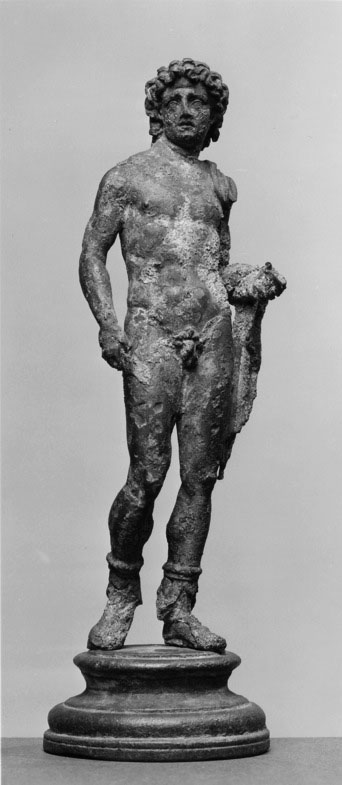Earlier this year, Spencer Elden filed a lawsuit against the band Nirvana for using his nude image as a child on the album cover of the hit record “Nevermind.” Though the suit was founded in Elden’s trauma after having his nude image used with neither his nor his guardians’ consent, it struck a much bigger conversation about the way we view nude bodies, specifically those of children and women, in the artistic scene. A consensus of critics and activists on one side of this argument’s spectrum seemed to pose the offense that the usage of nude images in art is inherently pornographic, and that by this logic, the use of children’s nude images specifically—whether that be in contemporary art or art from 500 years ago—ought to be frowned upon, if not eradicated in future circumstances.
This mode of thinking draws forth a multitude of concerns for the most part, is fraught with generalizations that further adulterate the true meaning of the argument. While it seems as though these people are well-intentioned in arguing that what happened in Elden’s case is indisputably wrong (I mean, come on! Non-consensually using naked pictures of someone’s child is definitely illegal), they also miss a critical point: the human body is not inherently erotic. When we consider this, the argument against nude imagery, specifically in painted, consensual, or contemporary art, falls apart almost completely.
As we look back in history, throughout nearly all stages of life the human form in general has long been the subject of multiple modes of artistic expression, and for a good reason too: the human body is one of the most complex, emotive, and intimate subjects we see in nature. It communicates like no other subject occurring organically, because it is what we know. The most familiar subject is our own reflection. It takes a certain sort of perverseness to look at any depiction of the human body outside of explicitly sexual scenarios (i.e. intercourse and its subcategories) and instantly associate it with the erotic.
This way of observing the world also inherently suggests that the nude body of a child is implicitly sexual. By that measure, wouldn’t pictures our parents take of us in the bathtub be sexual, too? There needs to be a place in which we can draw the line between what is appropriate and what is not, just as we do in every aspect of life. It would appear that a somewhat distinct line can be drawn, then, from what Kenneth Clark, a renowned art historian, depicts as the difference between ‘being nude’ and ‘being naked.’
“To be naked is to be deprived of our clothes, and the word implies some of the embarrassment most of us feel in that condition. The word ‘nude,’ on the other hand, carries, in educated usage, no uncomfortable overtone. The vague image it projects into the mind is not of a huddled and defenseless body, but of a balanced, prosperous, and confident body: the body
re-formed.” With this in mind, we see the ways in which the nude painting — not naked — is a truly timeless cornerstone to art history.
Moreover, it is also worth noting that the aforementioned ‘no nudity’ argument typically only applies to paintings of women and children (you don’t see anyone going after Michelangelo’s David). Let us beg the question then: why? For one, women and children’s bodies are inarguably the most sexualized in contemporary Western society. The problem, then, has little to do with women and children’s nude bodies being actually sexual and much more to do with them being sexualized. By that measure, art itself is not the issue; rather, the way we’ve been programmed in the last 100 years to observe it is.
Unfortunately, that reception is often one which, due to the society we’ve built, is perverse. For some clarity on the reception of nudity in modern artwork, The Hill News spoke with Lindsay Lukehart ‘23, an Art and Art History major. “While it can be debated whether or not our culture is becoming more sexual or more naked—two opposing concepts,” Lukehart states, “the simple fact is that an artist cannot control their audience. A lot of renowned contemporary artists do not explain their work; they’re waiting for critics and audience members to decipher… I’m not saying nudity needs to become a taboo subject, because that would be worse, but I think there are a couple of art movements that aren’t widely popular and are great and combating bodily sexualization, like abject art.”
Perhaps, then, movements like abject art, which explores themes that transgress and threaten our sense of propriety (at least in reference to the body) are a non-explicit mode of exploring otherwise explicit topics. The point still stands, though: to eradicate nudity from art is to eradicate art’s intimacy, its humanity. The human body, whether male, female, young, or old, is something meant to be celebrated, if not appreciated and explored in the most non-sexual ways. The hyper-sexualization of children and women in Western culture has brought our society to a brink where apparently for many, it is difficult to observe an unassuming, nude body in artwork without feeling somewhat perverted.
Thus, the issue is not art, it is the way an audience observes it. Art is what we perceive it to be (just look at Comedian by Maurizio Cattelan, a banana taped to a wall that’s now selling for $120k). If as a society, we can take off the venereal red lenses with which we view artwork, perhaps then we can revert to observing nudity for what it really is: innocent human beauty.



